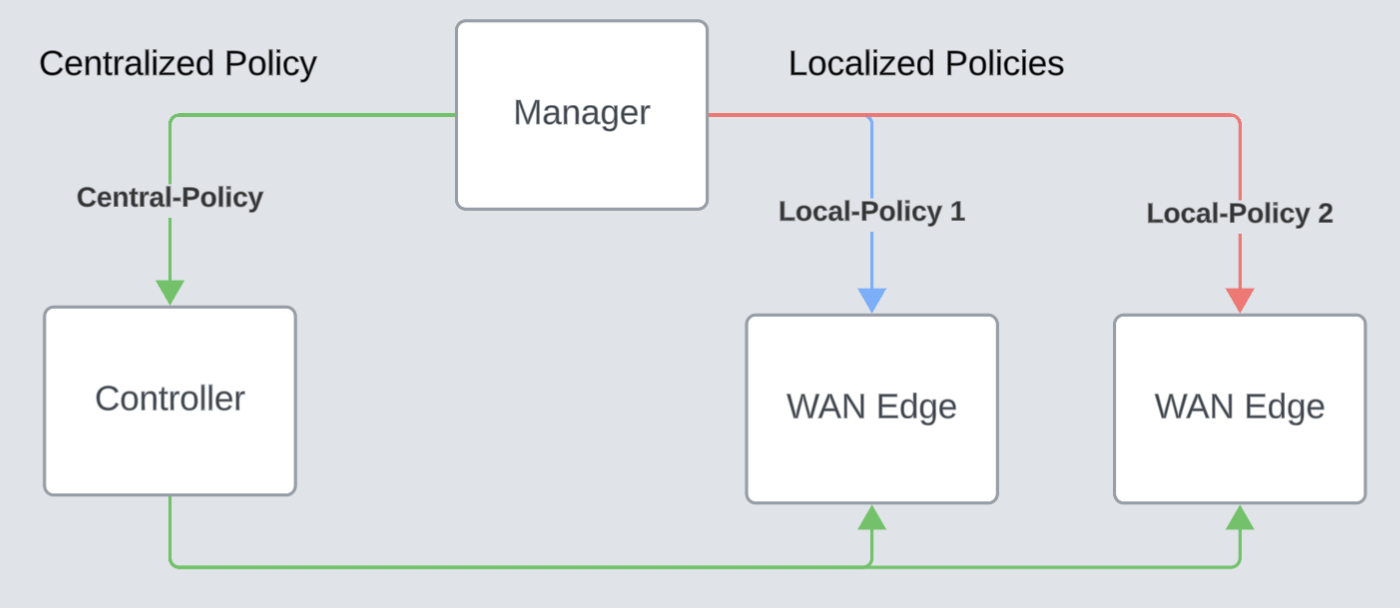Introduction
Cisco SD-WAN provides with powerful tools to shape both routing behavior and how traffic flows through the overlay. At the core of this flexibility are two key policy types: Control Policies and Data Policies. Understanding the difference between them is crucial for designing scalable and optimized SD-WAN deployments.
In this post, we’ll explore down what each policy type does, how they differ, and when to use one over the other.
Centralized and Localized Polices
Policies are categorized based on where they are configured and applied, they could be Centralized and Localized policies. The Manager uses netconf/yang to send policy configuration.
Centralized Policies
Configured on the Controller (vSmart) and pushed to a selected group of SD-WAN routers through Overlay Management Protocol (OMP). Includes:
- Control policies
- Data policies
- App-aware routing policies
Localized Policies
Configured directly on the SD-WAN routers and only affect that specific device. Includes:
- Local ACLs
- Route policies
- QoS settings

What Are Control Policies?
Control policies in Cisco SD-WAN are applied on the control plane - specifically, they define how routing information is exchanged between Controllers and SD-WAN routers.
Key characteristics:
- Applied on Controllers
- Influence route advertisements and TLOC propagation
- Define what routes are accepted, modified, or rejected
Typical use cases:
- Create topologies (hub/spoke, partial mesh, etc)
- Controlling route leaks between VPNs
- Filtering or tagging OMP routes
Think of control policies as a way to shape the SD-WAN topology itself by deciding which routes exist and where they are allowed to go.
What Are Data Policies?
Data policies, on the other hand, operate on the data plane. They define how actual traffic is handled.
Key characteristics:
- Also configured on the Controllers but applied on SD-WAN routers
- Operate at forwarding level, not related to route advertisements
- Can match on various fields: source/destination IPs, ports, applications, etc.
Typical use cases:
- Application-aware traffic steering
- Applying QoS classes
- Blocking certain types of traffic (for example, using ACL-style rules)
Using an analogy: Control policies are the city planners deciding where roads are built, data policies are the traffic rules that govern how vehicles move through them.
Key Differences at a Glance
| Feature | Control Policy | Data Policy |
|---|---|---|
| Plane | Control plane | Data plane |
| Applied on | Controller | Wan Edge |
| Affects | Route advertisements | Actual traffic forwarding |
| Common Use Cases | Route filtering, TLOC mapping | Traffic steering, QoS, ACLs |
| Directionality | Between controllers | From controller to edge routers |
Policy Execution Order
The following steps happen when a packet is passing through a WAN Edge router:

Local ingress policies, such as interface level ACLs and QoS settings, are applied first. These can filter packets and apply marking or re-marking for QoS.
Centralized Application-Aware Routing is evaluated next. It makes forwarding decisions only between equal-cost paths already present in the routing table.
Then, the centralized data policy is evaluated. It has the ability to override any forwarding decisions made by AAR.
Once policies are applied, the system performs routing and forwarding lookups to identify the appropriate egress interface.
Queueing and scheduling mechanisms are applied to shape traffic according to QoS settings.
Finally, the local egress policy is applied before the packet is placed on the wire.
Understanding this order is key to avoiding misconfigurations and ensuring your policies behave as expected. A common mistake is unintentionally overriding an AAR routing decision by applying a centralized data policy that matches the same traffic and redirects it elsewhere.
When to Use What
Choosing between control and data policies depends on what problem you’re solving:
- Want to limit which routes are shared between sites? → Use a control policy.
- Need to steer certain applications over MPLS or DIA? → That’s a data policy job.
- Trying to prevent route advertisement loops or control inter-VPN leakage? → Control policy.
- Looking to prioritize VoIP traffic or drop peer-to-peer file sharing? → Data policy.
In many designs, both are used together. For example, a control policy might ensure only selected prefixes are reachable between sites, while a data policy handles how the matching traffic is prioritized and forwarded.
Conclusion
Control and data policies serve distinct but complementary purposes in Cisco SD-WAN. One governs the topology and routing decisions, the other shapes how traffic moves through that topology.
Understanding these differences allows you to build smarter and more efficient SD-WAN environments. Want to go deeper? Check out Cisco’s official docs on Control Policies and Data Policies.
Also, check out my deep dive on Application-Aware Routing, and learn how SD-WAN can automatically move traffic to best performing paths and guarantee a good user experience.